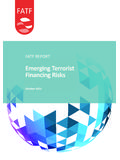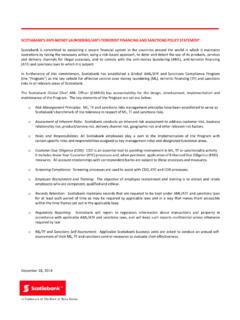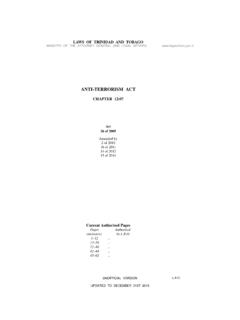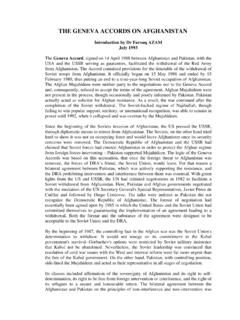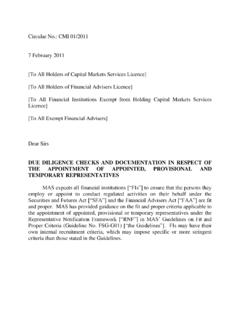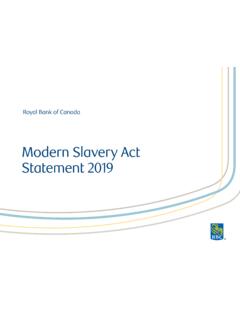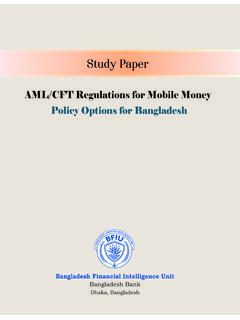Transcription of A SPECIAL TYPOLOGIES PROJECT REPORT ON POACHING, …
1 A SPECIAL TYPOLOGIES PROJECT REPORT ON POACHING, ILLEGAL. TRADE IN WILDLIFE AND WILDLIFE PRODUCTS AND ASSOCIATED. MONEY LAUNDERING IN THE ESAAMLG REGION. A SPECIAL TYPOLOGIES PROJECT REPORT ON. POACHING AND ILLEGAL TRADE IN WILDLIFE AND. WILDLIFE PRODUCTS AND ASSOCIATED MONEY. LAUNDERING IN THE ESAAMLG REGION. A SPECIAL TYPOLOGIES PROJECT undertaken by the ESAAMLG TYPOLOGIES Working Group, supported financially by the Government of the United States. June 2016. 1. TABLE OF CONTENTS. A. ABBREVIATIONS 4. B. BACKGROUND 5. C. EXECUTIVE SUMMARY 7. D. OBJECTIVES 9. E. METHODOLOGY 10. F. GAPS (LIMITATIONS) IN THE FINDINGS 10. G. DETAILED ANALYSIS OF FINDINGS 11-106. CHAPTER I WILDLIFE POACHING AND ILLEGAL TRADE IN RHINO.
2 HORNS AND ELEPHANT TUSKS. 1. General overview on risk of wildlife crimes 11. Risk of rhino and elephant poaching activities 13. Resourcing wildlife crime activities 22. The extent of prejudice to governments in value terms 30. CHAPTER II TRAFFICKING WILDLIFE PRODUCTS. 2. Methods used to transmit or move funds to the poaching activities 35. Trafficking of rhino horns and/or elephant tusks or parts of any other vulnerable wildlife 36. Methods of trafficking wildlife products 40. CHAPTER III UNDERSTANDING THE DEMAND SIDE OF WILDLIFE. AND WILDLIFE PRODUCTS. 3. Legal basis for importing wildlife and wildlife products to the Asia Pacific Region 44. Organisational arrangements underpinning poaching and the illegal trade in wildlife and wildlife products 46.
3 Criminalizing wildlife offences 46. Mechanisms to reduce risk of wildlife product trafficking 48. What happens to the confiscated wildlife products in the APG. Region? 49. CHAPTER IV UNDERLYING REASONS FOR ILLEGAL TRADE IN. WILDLIFE, RHINO HORNS AND ELEPHANT TUSKS. 2. Underlying reasons for poaching and wildlife trafficking activities 50. Indications of the retail prices of rhino horns and ivory 50. Retail market for rhino horns and ivory products 52. Summary of prosecutions and convictions for wildlife crime Offences 54. Linking wildlife crime activities to the demand in Asian Countries 55. Terrorist financing activities relating to wildlife crimes 56. The demand of ivory in the United States of America 58.
4 CHAPTER V WILDLIFE CRIME COMBATTING AND PREVENTIVE. MEASURES. 5. Preventative measures to combat poaching and wildlife trafficking in ESAAMLG region 63. Measures to detect and control wildlife/wildlife products Trafficking 64. Financial Intelligence Units 66. Law enforcement and investigative authorities 67. Law enforcement and international cooperation 68. Capacity for enforcement 70. Strategies of enforcement and their consequences 73. Legal framework 76. Customs and cross border movements 78. Challenges and proposed remedies 79. CHAPTER VI CASE STUDIES. Case studies: Methods used in poaching, smuggling and trading of protected wildlife products and some notable preventative measures 82.
5 7 CONCLUSION 104. 8 REFERENCES 106. ANNEXURE A: OVERVIEW OF THE NATIONAL WILDLIFE CONSERVATION. LAWS IN THE EIGHT FOCAL COUNTRIES. ANNEXURE B: INTERNATIONAL AND REGIONAL FRAMEWORK FOR. CONTROLLING WILDLIFE TRADE. 3. A. Abbreviations AML/CFT Anti-Money Laundering/Combating financing of Terrorism APG Member Countries Refers to countries in the Asian Pacific Region FATF style Review Body (FSRB). ESAAMLG Eastern and Southern Africa Anti Money Laundering Group FATF Financial Action Task Force FIU Financial Intelligence Unit KNP Kruger National Park LEA Law Enforcement Agencies ML Money Laundering ML/TF Money Laundering/Terrorist financing PEP Politically Exposed Persons SAR Suspicious Activity REPORT STR Suspicious Transaction REPORT TF Terrorist financing CITES Convention on International Trade in Endangered Species of Wild Fauna and Flora (CITES).
6 UNSC/S/RES United Nations Security Council SPECIAL Resolution USD United States Dollars (or US$). 4. B. Background 1. The majority of ESAAMLG member countries have vast resources in wildlife, which during the last few years have seen unprecedented targeting by both individuals and syndicates involved in poaching and other illegal wildlife activities. This typology PROJECT focused on poaching and illegal trade in wildlife and wildlife products and associated money laundering in the ESAAMLG Region. 2. Illicit wildlife trafficking is one of the most lucrative types of transnational organized crime today, with annual revenues estimated to be between USD billion and USD 10 billion per year1 (excluding fisheries and timber).
7 These illegal proceeds are suspected to be laundered into the financial systems worldwide. 3. Common to wildlife poaching is its localized and cross-border phenomenon which is often orchestrated by well organised, sophisticated and at times heavily armed poachers. The cross border nature of poaching puts the illegal activity beyond the capacities of most governments in the Region. Poaching invariably transcends into illegal wildlife trade which has been associated with well organised crime groups which through the unlawful trade and complex laundering means of the proceeds have amassed a lot of resources. The resources include immediate large amounts of disposable cash, modern technology and established corrupt transportation routes.
8 4. The Independent newspaper, a daily publication in Britain, reported on 6 February 2014 that the dangerous criminal networks that run the global wildlife trade have been allowed to persist and prosper as a result of chronic government failures to treat them seriously. The REPORT further states that the industry (dealing in illegal wildlife business) is the world's fourth biggest illegal trade after narcotics, human trafficking and counterfeiting. Feedback from regional wildlife NGOs (using former Police officers as consultants), indicated that the criminal networks involved in smuggling drugs, humans, extra are almost always the same networks involved in smuggling wildlife products. This is because they already have 1 According to a REPORT by US-based strategy and policy advisory firm Dalberg.
9 REPORT titled: Fighting illicit wildlife trafficking - A consultation with governments, conducted by Dalberg. Accessible at: 5. an established network and the wildlife product is just a different product. 5. The ESAAMLG region, given its vast resources in wildlife is uniquely placed to study and uncover the illegal trends in this industry, in an effort to assist governments of its member states and other stakeholders in setting up an informed policy framework on wildlife resources. 6. The findings in this REPORT also confirms that despite arresting traffickers and seizing illegal wildlife products, law enforcement have failed to arrest or convict, let alone confiscate/forfeit illegally acquired assets by the criminal masterminds wreaking havoc in this area across Africa.
10 A. REPORT by the Environmental Investigation Agency (EIA), which has been investigating illegal wildlife trade for more than three decades states;. Despite record seizures of illegal ivory, not a single criminal kingpin involved in the international illegal trade of ivory has been prosecuted and convicted to date. That is a damning indictment. With less than 3,500 wild tigers left, elephant numbers plummeting and rhinos under attack again, we need to get it right, 2. 7. Azzedine Downes, a researcher on wildlife poaching, in an article titled; When it comes to poaching, hate the crime not the criminal , highlights factors contributing to wildlife poaching being: the amounts of money generated, low risk of arrest, lenient penalties, killing and thefts done quickly, inexpensive and little social stigma associated with the crime (compared to other crimes such as murder, robbery, kidnapping, etc).
